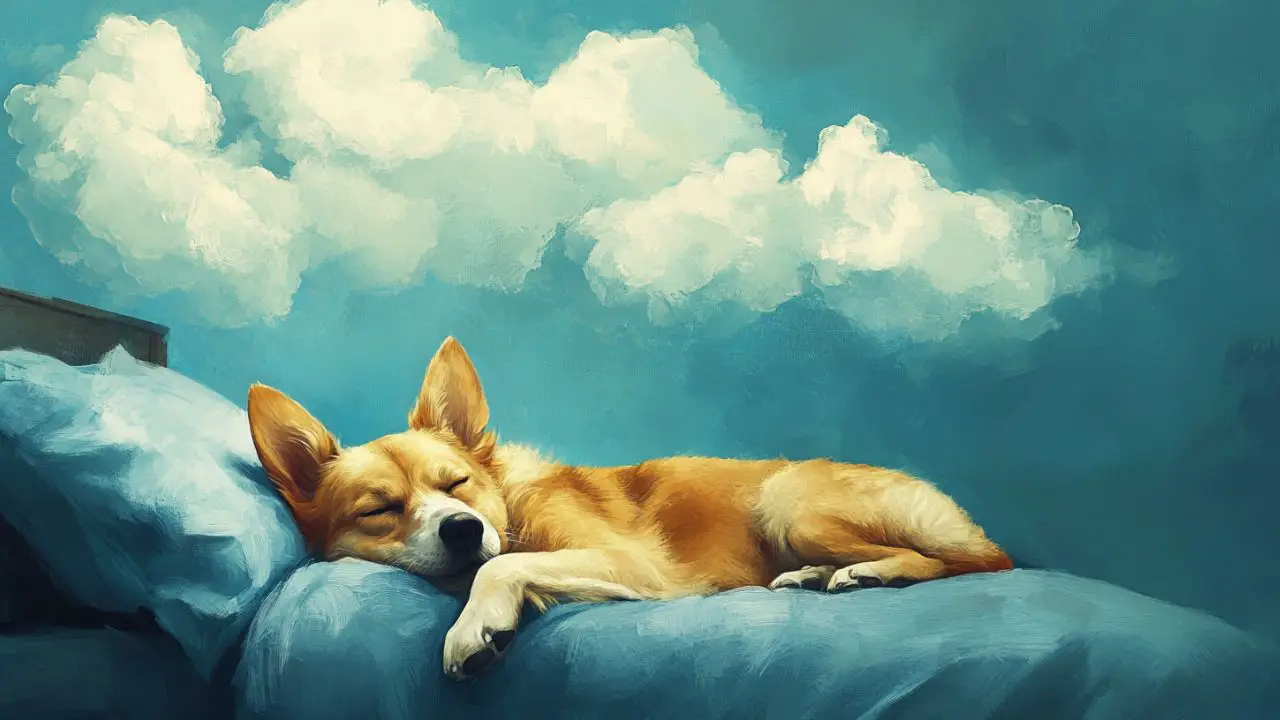Have you ever watched your furry friend twitch, whimper, or even bark softly in their sleep?
These adorable nocturnal antics have likely left you wondering what’s going on in your dog’s mind during their slumber.
In this article, we’ll explore the fascinating world of canine dreams, decoding the meanings behind those sleep behaviors and shedding light on what your dog might be experiencing in their dreamland adventures.
Do Dogs Really Dream?
Before we dive into the specifics of dog dreams, let’s address the fundamental question: do dogs actually dream?
The short answer is yes, dogs do indeed dream, much like humans and other mammals.
Scientific studies have shown that dogs experience similar sleep cycles to humans, including the REM (Rapid Eye Movement) stage where most dreaming occurs.
During REM sleep, a dog’s brain activity closely resembles that of their awake state, indicating that they are likely experiencing vivid mental imagery.
The Science Behind Canine Sleep
To understand dog dreams better, it’s helpful to know a bit about their sleep patterns.
Dogs typically spend about 50% of their day sleeping, with larger breeds often sleeping more than smaller ones.
Their sleep cycle consists of two main stages: non-REM sleep and REM sleep.
Non-REM sleep is a deeper, more restful stage, while REM sleep is when most dreaming occurs.
During REM sleep, you might notice your dog’s eyes moving rapidly behind closed lids, just like humans experiencing vivid dreams.
Decoding Common Sleep Behaviors
Twitching and Paw Movements
One of the most common signs that your dog is dreaming is subtle muscle twitches, especially in their paws.
These movements might mimic running or walking, suggesting that your dog could be dreaming about chasing a squirrel or going for a walk.
Some dogs even make paddling motions, as if they’re swimming in their dreams.
Whimpering or Soft Barking
If you hear your dog making soft vocalizations during sleep, they might be reacting to something in their dream.
A whimper could indicate excitement or mild distress, while a soft bark might mean they’re alerting you to something in their dreamworld.
These sounds are usually much quieter than when your dog is awake, as their body is partially paralyzed during REM sleep to prevent them from acting out their dreams.
Tail Wagging
Occasionally, you might spot your dog’s tail gently wagging during sleep.
This could be a sign that they’re experiencing a particularly happy or exciting dream.
Perhaps they’re dreaming about playing with their favorite toy or receiving treats from their beloved human.
Rapid Eye Movements
While your dog’s eyes are closed, you might notice them moving rapidly beneath the eyelids.
This is a clear sign that your dog has entered REM sleep and is likely in the midst of a vivid dream.
The eye movements might correspond to your dog “watching” the events unfold in their dream world.
What Do Dogs Dream About?
While we can’t ask our dogs to describe their dreams in detail, researchers believe that dogs likely dream about their daily experiences, much like humans do.
This means your dog might be reliving their favorite activities, like playing at the park or snuggling with you on the couch.
They might also process new experiences or work through challenges they’ve encountered during the day.
Some studies suggest that different breeds might dream about activities they were originally bred for, such as herding or hunting.
Should You Wake a Dreaming Dog?
It’s generally best to let sleeping dogs lie, even when they’re in the midst of an active dream.
Waking a dog during REM sleep can be disorienting for them and might even lead to a startle response.
If your dog seems distressed in their sleep, it’s okay to gently call their name or speak softly to them, which may help them transition out of the dream naturally.
Do Dogs Have Nightmares?
Just as dogs can have pleasant dreams, they may also experience less enjoyable ones.
Signs of a potential nightmare include more intense muscle twitches, louder vocalizations, or signs of distress like whining.
These dreams might be processing scary or stressful experiences from their day.
If your dog frequently seems distressed during sleep, it’s worth discussing with your veterinarian to rule out any underlying issues.
How to Support Healthy Sleep and Dreams for Your Dog
To ensure your dog has pleasant dreams and restful sleep, there are several things you can do:
Provide a comfortable, quiet sleeping area for your dog.
Maintain a consistent daily routine to reduce stress and anxiety.
Ensure your dog gets plenty of physical and mental stimulation during the day.
Address any health issues promptly, as pain or discomfort can affect sleep quality.
Consider calming aids like pheromone diffusers or anxiety wraps if your dog seems stressed at bedtime.
Conclusion: The Dreamy World of Canine Slumber
Understanding your dog’s dreams adds another layer to the deep bond we share with our canine companions.
While we may never know exactly what adventures they’re having in their sleep, we can appreciate that their rich inner lives continue even as they snooze.
The next time you catch your furry friend twitching, whimpering, or softly woofing in their sleep, take a moment to imagine the delightful dreamscapes they might be exploring.
Perhaps they’re reliving your latest game of fetch, chasing dream squirrels, or simply basking in the joy of being your loyal friend.
Sweet dreams, indeed, for our four-legged family members.
SHARE now with your friends!
- Hero Farm Dog Survives Epic Battle with Coyote Pack - December 9, 2024
- The 10-Minute Bedtime Routine That Changed My Dog’s Sleep Forever - November 29, 2024
- Creating a Safe Space for Nervous Pets: Your Guide to Pet-Friendly Havens - November 25, 2024

